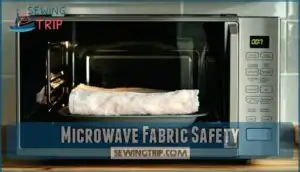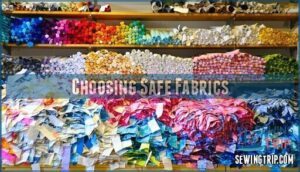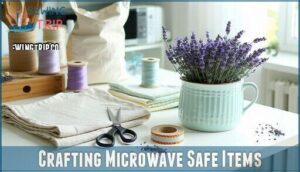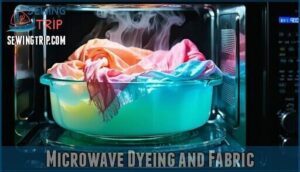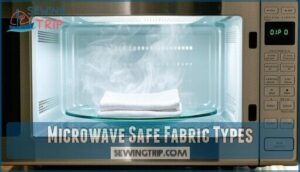This site is supported by our readers. We may earn a commission, at no cost to you, if you purchase through links.
 Yes, you can microwave fabric, but it’s all about choosing the right material.
Yes, you can microwave fabric, but it’s all about choosing the right material.
Natural fibers like cotton, linen, and wool are your safest bets—they can handle heat without breaking a sweat.
Steer clear of synthetic fabrics like polyester or rayon, though. They can melt, release toxins, or even ignite.
Never microwave fabrics with metallic threads or embellishments unless you want sparks flying! A clean, 100% cotton item works great for projects like microwaveable heat packs.
Just remember, too much heat can scorch it, so warm it up in short bursts. Looking for more tips? Stick around for clever ideas and safety hacks!
Table Of Contents
- Key Takeaways
- Microwave Fabric Safety
- Can You Microwave Fabric
- Choosing Safe Fabrics
- Microwave Heating Pack Materials
- Crafting Microwave Safe Items
- Microwave Dyeing and Fabric
- Microwave Safe Fabric Types
- Microwaving Fabric for Crafting
- Practical Applications of Microwaved Fabric
- Ensuring Microwave Fabric Safety
- Frequently Asked Questions (FAQs)
- Conclusion
Key Takeaways
- Stick to 100% natural fabrics like cotton, linen, and wool for safe microwaving; avoid synthetics like polyester as they can melt or ignite.
- Always check for untreated fabrics without metallic threads or embellishments to prevent sparks or fire hazards.
- Heat items in short intervals (20–30 seconds) and monitor closely to avoid overheating or burning.
- Slightly dampen fabrics to reduce fire risks, and avoid microwaving anything treated with chemicals or synthetic coatings.
Microwave Fabric Safety
Not all fabrics are safe to microwave, so it’s important to understand what works and what doesn’t.
By sticking to natural materials like cotton and avoiding synthetics, you can prevent accidents and guarantee safe use.
Natural Fibers Like Cotton
Cotton is a go-to for microwave fabric safety, offering reliability, heat resistance, and versatility.
Its natural fibers prevent overheating and don’t release harmful fumes, making it ideal for heating packs or similar projects. Cotton’s durability and absorbency also shine, especially in tightly woven options.
Always test items in short intervals to avoid mishaps.
- Why cotton works: Resistant to heat, won’t melt.
- Top choices: 100% cotton, organic, or unblended.
- Great alternatives: Linen, hemp, or untreated wool.
- Monitor carefully: Stay safe with short microwave bursts.
Synthetic Fibers to Avoid
Some fabrics don’t belong in the microwave—they’re like a fire hazard waiting to happen.
Synthetic fibers such as polyester, rayon, and nylon can melt or release toxic fumes, creating serious risks.
Acrylic and spandex? Even worse—flammable and unpredictable.
- Polyester dangers: Melts quickly, releases toxic fumes.
- Rayon risks: Weakens, may overheat or catch fire.
- Acrylic flammability: Highly combustible.
- Nylon hazards: Burns under heat, hard to control.
Can You Microwave Fabric
Heating fabrics in a microwave isn’t as simple as reheating leftovers—it’s a mix of science and safety.
Microwaving fabric combines creativity and caution—a balance of materials, heat, and safety for stress-free, functional results.
Natural fibers like cotton, wool, and linen can handle the heat for short periods (30-60 seconds), while synthetics like polyester and polar fleece are disasters waiting to happen—they melt, release fumes, and could start a microwave fabric fire.
Always test small pieces to avoid fabric microwave damage. And remember, glitter fabrics, elastic, or treated materials? Say goodbye! They’re just not worth the clothing damage or risky outcomes.
Choosing Safe Fabrics
When choosing fabrics to microwave, stick to 100% natural materials like cotton, linen, and wool, which handle heat safely and easily.
Avoid synthetics like polyester and rayon, as they can melt, burn, or release harmful fumes.
Cotton and Linen Options
When microwaving fabric, natural fibers are your safest bet. Cotton and linen stand out for their heat tolerance and practicality.
Here’s why they’re worth it:
- Cotton Absorbency: It locks in heat well—perfect for warmers.
- Linen Durability: Lightweight yet sturdy enough for repeated use.
- Weave Types: Breathable weaves handle heat and moisture perfectly.
- Blending Options: Avoid blends; stick with 100% natural fibers.
- Sustainable Sourcing: Eco-friendly and safe for microwave projects.
Test and check your materials—your safety matters!
Wool and Flannel Considerations
Wool and flannel can handle the microwave well—as long as you play it smart.
Wool, especially when damp, retains heat longer but watch out for shrinkage if it’s not 100% natural.
Flannel is durable, but its composition matters since blends might spark safety concerns.
Stay cautious to avoid fabric microwave risks.
- Use damp wool for heat retention.
- Test flannel composition for synthetic fibers.
- Stick to 100% natural options.
- Monitor heating time to prevent overheating.
- Avoid fabric shrinkage by testing small pieces first.
Avoiding Polyester and Rayon
Polyester dangers and rayon risks make these synthetic fibers unsuitable for microwaving—they can melt, release toxic fumes, or even ignite.
Before heating fabric, always check if it’s synthetic to avoid a microwave mishap. Sticking with safe, natural alternatives like cotton or linen is a simple way to sidestep these hazards.
Here’s a quick comparison:
Choose natural alternatives wisely to ensure microwave safety and avoid synthetic fibers that can cause a microwave mishap.
Microwave Heating Pack Materials
When making a heating pack, you’ll need materials that are both microwave-safe and effective at holding heat.
Natural fillers like rice and fabrics like 100% cotton are the best choices to guarantee safety and comfort.
Rice Filling for Heat Distribution
For homemade heating pads, rice filling is a superstar.
Its natural moisture content guarantees excellent heat retention, while different grain types add variety to how warmth lasts.
Whether crafting heat packs or experimenting with filling alternatives, balance is key—don’t overstuff!
Rice properties make it simple to create reliable microwave-ready warmth that feels just right for cozy, even heating.
Synthetic Tube Socks for Homemade Packs
Synthetic tube socks might seem like an easy choice for homemade heat packs, but they’re risky.
Synthetic fibers can melt, release toxic fumes, or even spark fires. Instead, go with natural fabrics for safe pack construction.
- Melting Point Dangers: Synthetic fibers break down under heat, creating flammable risks.
- Toxic Fume Release: Heating these socks can release harmful chemicals.
- Sock Alternative Fillers: Opt for cotton, wool, or flannel for safety.
It is possible to buy synthetic socks online.
Commercial Pack Safety Features
In the context of commercial heating packs, manufacturers think ahead to keep you safe.
These packs are built with tamper resistance and childproofing mechanisms to prevent unwanted accidents.
Many include synthetic fleece covers, which provide comfort and insulation while sticking to material certifications for microwave fabric safety.
Clear labeling standards guarantee you know exactly how to use them—no guesswork involved.
They also go through rigorous testing for heat seal integrity and durability, meaning they won’t leak or break after heating.
It’s all about durable materials and user-friendly designs that prioritize microwave safety.
Manufacturing standards enforce strict safety precautions, from proper insulation to overheating prevention.
With these quality details, commercial packs are reliable tools that keep you warm and stress-free without worry.
Crafting Microwave Safe Items
When crafting microwave-safe items, focus on materials that can handle heat without melting or burning.
Stick to natural fabrics like 100% cotton, and consider adding simple touches like lavender buds for a soothing effect.
Upcycling Old Flannel Shirts
Upcycling old flannel shirts is a fantastic way to embrace sustainable fashion and spark creative DIY projects.
Flannel’s softness and durability make it ideal for fabric microwave crafts like heating pads or bowl cozies.
Choose patterns that charm you, and always prioritize safety checks—stick to 100% natural fibers.
Reinforce the seams for sturdiness, and don’t stress about small imperfections—they add character to your projects while reducing waste brilliantly!
Using 100% Cotton Embroidery Floss
If you’re repurposing old flannel shirts into microwave-safe crafts, using 100% cotton embroidery floss keeps your projects safe and sturdy. This floss pairs perfectly with natural fabrics, and it offers excellent heat resistance during microwaving.
Here’s why it’s a winning choice:
- Safely absorbs microwave heat, avoiding singeing.
- Stays vibrant, addressing colorfastness concerns.
- Supports strong stitching techniques without breaking.
- Enhances project suitability with consistent thread count.
- Maintains fabric microwave safety for reliable results.
Consider exploring options for high quality floss to guarantee the best results. Stick to 100% cotton embroidery floss for worry-free, durable, and microwave-friendly creations.
Adding Lavender Buds for Scent
For a relaxing touch, try adding lavender buds to your rice heating packs. With known lavender benefits like calming effects, they enhance scent concentration and heating longevity.
It’s important to use microwave safe thread when creating these packs. Stick to a 4-tablespoon-per-cup ratio for balance.
Exploring alternative scents? Chamomile and mint make great options for DIY blends.
| Item | Amount | Purpose |
|---|---|---|
| Lavender Buds | 4 tablespoons | Calming effect |
| Rice | 1 cup | Heat retention |
| Chamomile/Mint (optional) | As preferred | Alternative scent |
Microwave Dyeing and Fabric
You can use your microwave to dye fabrics quickly, but you’ll need to choose the right materials.
Stick to natural fibers like cotton, and always avoid synthetics that could melt or release harmful fumes.
Avoiding Heat Sensitive Fibers
Not all fabrics play nicely with heat-sensitive microwaves.
Synthetic fibers like rayon, nylon, and acrylic? They’re the troublemakers, posing flammability hazards or releasing toxic fumes. Stick to natural fibers for microwave safety.
- Rayon: Easily overheats, risking damage.
- Nylon: Low melting points mean disaster.
- Acrylic: Emits harmful chemical release under heat.
Choose wisely; your microwave will thank you!
Using Stovetop Method for Synthetics
For heat-sensitive fibers like synthetic fabrics, the stovetop method is your best ally.
Gently simmer synthetic blends near boiling in stainless pots, guaranteeing controlled synthetic heating for vibrant results.
This approach prevents melting or damage, and always use proper dyeing equipment—like gloves—to maintain safety.
Skip microwaves for synthetic dyeing; stovetop synthetic safety guarantees even heat, making dyeing methods reliable every time.
Pre-Treating Damaged Garments
Freshening up worn fabric starts with prepping it right.
Pretreat for color restoration using these repair techniques:
- Tackle fabric stains with Rit Color Remover, including tricky bleach stain removal.
- Inspect the fibers—stains or mildew on severely worn pieces might resist repair.
- For sun damage repair, rinse and soak thoroughly before dyeing to rejuvenate those faded hues.
Some crafters utilize microwave dyeing methods for vibrant colors.
Microwave Safe Fabric Types
When choosing fabrics for microwave use, stick to 100% natural options like cotton or linen to guarantee safety. Avoid synthetic blends, as they can melt, ignite, or release harmful fumes.
Natural Fibers Like Cotton and Linen
In terms of microwave fabric safety, natural fibers like cotton and linen stand out.
Natural fibers like cotton and linen are the champions of microwave safety—durable, heat-resistant, and perfect for crafting worry-free projects.
Cotton’s impressive absorbency keeps it heat-friendly, while linen’s durability guarantees lasting results. Plus, their fiber breathability means less risk of overheating.
You should also be aware of microwave fabric safety when choosing materials. Stick with untreated fabrics for safe results and embrace natural sourcing for eco-friendly crafting.
| Fiber | Absorbency | Durability | Microwave Safe |
|---|---|---|---|
| Cotton | High | Moderate | Yes |
| Linen | Moderate | High | Yes |
Avoiding Synthetic Fibers Like Polyester
Polyester is trouble in a microwave—it melts, smokes, and risks fire hazards.
To stay safe, follow these tips:
- Skip synthetic fabrics like polyester or nylon.
- Choose natural materials such as cotton and hemp.
- Beware of coatings, which can spark or melt.
- Test fabrics briefly before prolonged use.
- Avoid synthetic blends, even if labeled “microwave-friendly.”
Considering Fabric Thickness and Density
Thicker fabrics and denser weaves can affect microwaving.
Thickness impacts how heat penetrates, while dense materials may trap moisture unevenly.
Always test before use to avoid surprises!
Here’s a quick guide:
| Fabric Type | Thickness Range | Heat Penetration |
|---|---|---|
| Cotton Flannel | Medium | Even |
| Wool | Thick | Moderate |
| Linen | Thin to Medium | Consistent |
Stay cautious—test fabric reactions for safety!
Microwaving Fabric for Crafting
You can use your microwave for creative fabric projects, but safety comes first. Stick to natural materials like 100% cotton, avoid metallic threads, and watch closely to prevent overheating.
Creating Patterns and Designs
Microwave dyeing is a playful way to explore fabric microwave art.
Small, controlled bursts of heat can create stunning effects.
Follow this simple tutorial:
- Try fabric steaming for sharp lines or resist techniques.
- Use the microwave for quick color fixation or gentle pattern distortion.
Experiment with creating patterns and designs, but monitor closely to avoid damaging natural fibers.
For best results, use cotton and linen due to their heat resistance.
Using Microwave Safe Materials
Pick natural fabrics like cotton or wool for microwave-safe projects—they’re reliable and heat-tolerant.
Always opt for untreated fabrics and safe fillings like rice or lavender.
Avoid blends to guarantee microwave safety, as synthetic fabrics often melt or burn.
Test materials in short intervals and trust your instincts—crafting with microwavesafe fabrics should feel as easy as warming leftovers.
Avoiding Metallic Content
Metallic threads or zippers in fabrics? Not a good idea for microwaving—they can spark fires faster than you’d think.
To guarantee safety:
- Avoid metallic threads, glitter, or coatings.
- Remove zippers, studs, or pearl embellishments.
- Check labels for metallic elements.
- Inspect seams or trims for hidden metal.
- Stick to 100% natural materials.
Microwave-safe crafting starts with skipping these hazards—your creation (and microwave) will thank you!
Practical Applications of Microwaved Fabric
You can use microwaved fabric for practical projects like heating packs or reusable hand warmers, making them both functional and easy to customize.
From soothing sore muscles to creating unique designs, these applications are simple and versatile, and they offer a range of benefits, including being practical.
Handwarmers and Neck Relievers
DIY handwarmers and neck relievers make chilly mornings bearable. Using rice-filled, microwavable heating pads guarantees excellent heat retention, while flaxseed doubles as aromatherapy.
Lightweight materials like cotton boost fabric durability. Microwave time? Just 1–2 minutes for cozy relief.
Reheating frequency depends on usage, but they last long!
| Feature | Benefit |
|---|---|
| Rice filler | Excellent heat retention |
| Flaxseed | Adds soothing aromatherapy |
| Cotton fabric | Lightweight and durable |
| Microwave time | Quick and efficient (1–2 mins) |
| Reheating uses | Long-lasting practical solution |
Reusable Microwave Bags
Reusable microwave bags make heating food or easing aches a breeze. When crafting your bag, verify it’s made with microwavesafe fabrics like cotton or linen for durability and safety.
Here’s how to make it practical:
- Choose bag materials that handle heat well, like 100% cotton.
- Use secure sealing methods—tight stitching or Velcro works best.
- Prioritize easy-to-clean materials for convenience.
- Customize size variations for snacks or comfort.
- Follow fabric safety tips for worry-free use.
Many people purchase pre-made microwaveable food pouches for convenience.
Fabric Cooking for Unique Designs
Microwaving fabric isn’t just for crafting—it’s a canvas for creativity! Natural fibers like cotton and linen thrive in a fabric microwave oven, revealing textures, sculpting possibilities, and even color changes.
Want to try fabric cooking? Experiment with steam shaping or layering techniques to create unique designs for quilts, clothes, or décor.
Steer clear of synthetics like polyester, as they can melt or spark trouble. Keep experiments simple: start with small pieces, short heating cycles, and watch carefully.
Remember, this microwave fabric experiment is all about testing design limitations while staying safe. Your next masterpiece might just come from the microwave!
Ensuring Microwave Fabric Safety
If you’re microwaving fabric, staying safe means knowing what materials can handle the heat.
Always watch for overheating, and stick to natural, untreated fabrics like 100% cotton to avoid unexpected sparks or burns.
Avoiding Overheating and Burning
Avoiding fabric mishaps in the microwave is easier than you’d think.
Start small and manage risks by:
- Safe Intervals: Heat fabrics in 20-30 second bursts.
- Moisture Levels: Slightly dampen fabrics, avoiding excess water.
- Fabric Thickness: Thicker fabrics need lower power settings.
- Power Settings: Adjust to medium or low to minimize overheating.
- Immediate Monitoring: Watch closely to prevent burning or fire hazards.
Keep things simple and safe!
Following Safety Guidelines for Microwaving Fabric
Mastering microwave fabric safety doesn’t have to be tricky—it just takes a few smart steps. Always use Safe Fillers and Untreated Fabrics, and stay clear of metallic embellishments.
Stick to low wattage and short heat increments, and never leave items unattended—Supervise Microwaving closely to avoid mishaps.
| Key Safety Tip | Why It Matters |
|---|---|
| Use Untreated Fabrics | Reduces risk of chemical fumes |
| Test Blends Before Use | Guarantees microwave compatibility |
| Avoid Metallics | Prevents sparks and fire risks |
| Allow Ventilation | Avoids overheating or pressure |
Follow these microwave safety guidelines every time!
Frequently Asked Questions (FAQs)
Can You microwave fabric?
Imagine this: you’re crafting a rice-filled heating pad from cotton.
Yes, you can microwave fabric, but stick to 100% natural ones like cotton or linen.
Avoid synthetic blends—they can melt or spark trouble, which is why it’s crucial to choose the right material, like cotton.
Can You microwave cotton towels?
Cotton towels can go in the microwave if they’re 100% cotton and free of synthetic blends or metallic threads.
Always dampen the towel first, as dry fabrics may burn.
Monitor closely to avoid overheating.
What fabrics are microwave safe?
Did you know 100% cotton, linen, wool, and hemp are microwave-safe?
Stick to untreated, all-natural fabrics without synthetic blends or metallic threads.
They’re heat-resistant, eco-friendly, and perfect for heating pads or bowl cozies!
Is cotton fabric microwave safe?
You can safely microwave 100% cotton fabric as long as it’s untreated, with no synthetic blends or metallic elements.
Cotton absorbs heat evenly, making it perfect for heating pads or cozy microwaveable crafts.
Always monitor closely, ensuring the cotton is used safely.
Can You microwave 100% cotton?
Imagine heating a homemade rice pack for sore muscles.
Yes, you can microwave 100% cotton!
It handles heat well if untreated, free of metallics, and combined with safe fillers like rice or flaxseed.
How long do you microwave a cotton fabric?
Heat 100% cotton fabric in the microwave for 1-2 minutes, depending on its thickness and size.
Always monitor it closely to avoid overheating, and make certain it’s slightly damp to prevent scorching or fire risks.
Is It Safe to Microwave Fabric That Has Been Treated With Chemicals?
It’s risky to microwave fabric treated with chemicals.
These treatments can react unpredictably to heat, potentially releasing harmful fumes or causing fires.
Always check fabric composition and avoid microwaving if you’re unsure about chemical treatments.
What Temperature Should I Set the Microwave to When Microwaving Fabric?
About 85% of fabrics require no more than medium heat in microwaves, between 200-300°F.
Stick to short, 1-2 minute bursts, and always monitor closely to avoid overheating.
Testing patience isn’t worth a fabric fire!
Are There Any Special Instructions for Microwaving Velcro Fabric?
If you’re microwaving Velcro fabric, avoid exposing it to high heat or liquids.
Keep an eye on it, use short intervals, and make certain it’s free from synthetic materials or metallic components to stay safe.
Are There Any Special Considerations for Microwave-safe Batting?
Choose 100% cotton batting for microwave use, avoiding blends or synthetics.
Look for untreated, chemical-free options.
Prewash to remove residues, and always test in short intervals to prevent overheating or unexpected reactions.
Safety first is crucial, so always prioritize it to ensure safety.
Conclusion
Did you know that natural fibers like cotton can withstand microwave heat better than synthetics?
If you’re wondering, "Can you microwave fabric?" the answer is yes—if you pick the right materials.
Stick to 100% cotton, linen, or wool for safe results, and steer clear of polyester or anything metallic.
Always heat in short intervals to avoid scorching.
With these simple tips, you can safely create heat packs, crafts, or even unique fabric designs using a microwave!

